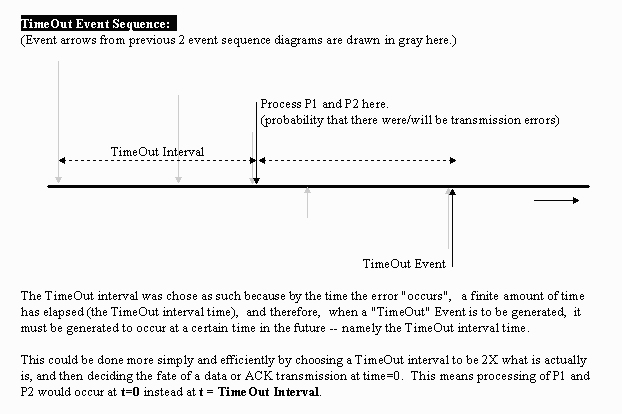Written by Tom Laramee for use in the senior level ECE course in Computer Networks 597A, and for use in the graduate-level course ECE671.
Here are the lecture notes I gave out when presenting the simulation of the protocol Selective Repeat. These notes detail the various events involved in the simulation of this protocol, how they are generated, and how they are processed.
[ Tutorial Index | Lecture Notes | Skeleton Simulation Code | Media Access Simulation Code | Data Link Layer Simulation Code ]- W = Window size (in frames)
- l = Channel length (in frames)
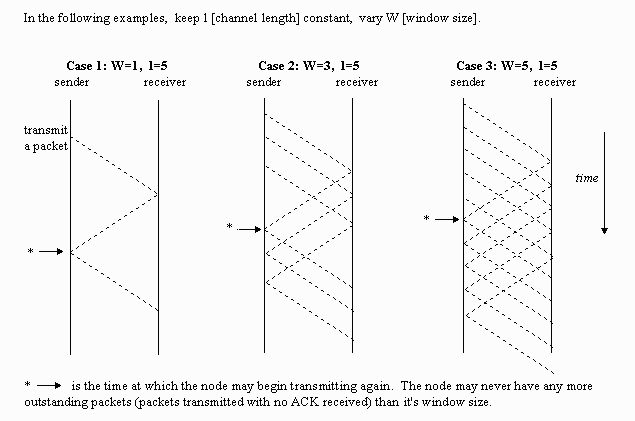
When the channel length is 5, but the window size is only 1 (case 1), the sender may never have more than 1 packet outstanding at any given time. Therefore, most of the time is spent witing for ACKs from the receiver while channel bandwidth is wasted (free bandwidth goes unused).
When the channel length is 5, and W=3 (case 2), the utilization is better -- except time is still wasted because the sender hits the window size before receiving an ACK for it's 1st packet.
So, when channel length is 5, and W=5 (case 3), there is never a time when the sender is idle. Therefore, maximum efficiency is attained here with no channel bandwidth going unused.
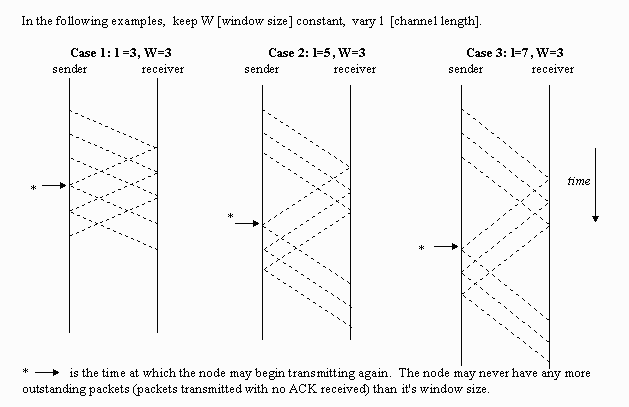
Now, in case 1 above, the Window size (W) is help constant and the channel length is varied. It can be seen that the longer the channel length, the lower the efficiency acheived. This is the same picture as in the previous figure, except here we're holding W fixed and varying l (channel length).
These are the various functions which are directly related to the simulation of the Selective Repeat protocol.
| Event Type | Function the generates event | Function that processes event |
|---|---|---|
| FrameArrival | gen_arrival | processFrameArrvial |
| Departure | gen_depart | processDeparture |
| NodeFree | gen_nodefree | processNodeFree |
| AckArrival | gen_ackarrival | processAckArrival |
| TimeOut | gen_timeout | processTimeOut |
These are various functions which can/may be used for simulating all protocols -- they're essentially debugging and utility functions.
| Name | Description |
|---|---|
| initParams | Parse command line arguments and intialize appropriate variables. |
| initAll | Initialize ALL variables. |
| showParameters | Show values of important parameters before simulating. |
| showReport | Show the report at the end of the simulation. |
| showEventList | Show the current event list. |
| showCurrentEvent | Show the current event. |
| printQueue | Print out the queues contents. |
| postCycleOP | Print OP at the end of processing an event. |
| queueItUp | Take a packet and put it into a node's queue. |
Before looking at these individual events, it might be helpful to look at a complete event cycle (shown below).
NOTE: All of the following data is taken from pg 240, Computer Networks, Andrew S. Tannanbaum
Generate Poisson arrivals. The only parameter you have control over (as the programmer) is lambda - the channel arrival rate.
F = Frame length is bits.C = Channel capacity in bits / second.
I = Interrupt and service time.
A = Acknowledgement length (in bits).
T = Timeout interval.
F = D + H; // Number of bits / frame I = (double)(l*F)/C; // channel length = IC / F timeXPacket = (double)F/C; // packet transmission time timeXAck = (double)A/C; // ACK transmission time T = timeXPacket + I; // timeout // I = (F/(2.0*C))*(2.0*W + I); //used to test 50% utilization case
The node is free after the last bit of the data packet has been transmitted.This is given by:
time = F/C
Arrival of a data packet to a receiver. This is after 3 things have happened:
- Last data bait have arrived to the receiver.
- The interrupt has been serviced.
- Receiver is ready to begin transmitting the ACK
This time is given by the expression:
time = F/C + I
This is when the ACK arrival has been transmitted by the node which sent the data frame. This time is given by the expression:
time = F/C + I + A/C
This is when a node has not revied an ACK for an outstanding packet. After a certain time, (Timeout Interval - T), the node times out and requeues the missing packet. This timeout inteval is given by the expression:
F/C + I
See Timeout event sequence (above) for explanation of why this is so.This 1st event sequence (shwon below) shows a typical event sequence for a suuccessfully transmitted data frame and it's ACK. This various times are shown on the figure.
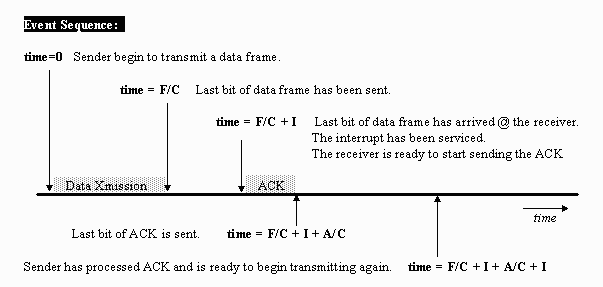
This 2nd event sequence (shown below) is the same as the 1st sequence, except the various events are named.
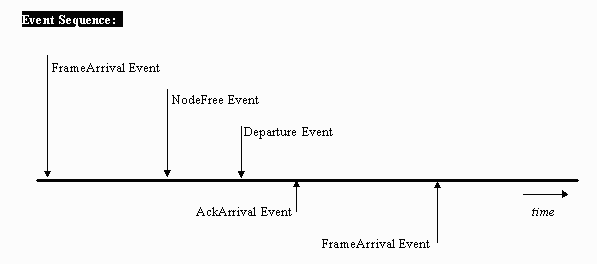
This shows a typical timeout sequence (shown below):
